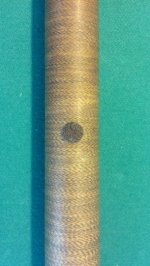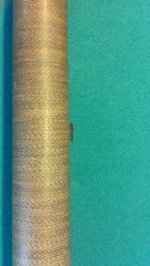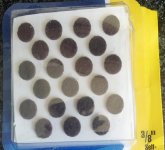You are using an out of date browser. It may not display this or other websites correctly.
You should upgrade or use an alternative browser.
You should upgrade or use an alternative browser.
Question for B. Jewett on VEPP
- Thread starter dearnold
- Start date
It would appear that on the cue you are using, there is a line drawn on the ferrule. Is there and what do you use that for? Is this on your normal playing cue or was this something for the VEPP series.
Regards
i have heard that the grains of a shaft will make it play different depending on the orientation
so a line on the ferrule ensure that you are always playing with your shaft grains aligned the same
it also gives you feedback if your stroke is straight
I've been doing that for about 30 years. I don't know if it makes any difference or not but getting "up" up is part of my shot routine. In addition to the grain thing mentioned above, the tip can also vary. Also, if I'm playing a draw shot, I only have to check one part of the tip.It would appear that on the cue you are using, there is a line drawn on the ferrule. Is there and what do you use that for? Is this on your normal playing cue or was this something for the VEPP series.
Regards
Bob,
What did you use to put the line there?
Randy
What did you use to put the line there?
Randy
I've been doing that for about 30 years. I don't know if it makes any difference or not but getting "up" up is part of my shot routine. In addition to the grain thing mentioned above, the tip can also vary. Also, if I'm playing a draw shot, I only have to check one part of the tip.
Funny -
I would have thought it had something do with aiming, not twisting, etc. Wouldn't hitting every shot on one part of the tip cause some uneven deforming?
Regards
The line stays up which means all the parts of the tip are used. I have not seen any uneven wear except when I've been practicing power draw shots and the miscues get the top of the tip.Funny -
I would have thought it had something do with aiming, not twisting, etc. Wouldn't hitting every shot on one part of the tip cause some uneven deforming?
Regards
A permanent marker works OK but eventually is not permanent.
Do you have a picture of your ferrule, Bob?
I've often wondered about doing something like this.
I've often wondered about doing something like this.
Do you have a picture of your ferrule, Bob?
I've often wondered about doing something like this.
Sure. See this article: http://www.sfbilliards.com/articles/2002-11.pdf
CAUTION! If you are from the Tribe of Borers you may find the article offensive.
Great article, Bob. I'm pretty fanatical about chalking correctly. I apply it like lipstick. Not that I'd know what that's like or anything. 
I have a couple of questions.
1. How do you choose where to put the line initially? Is there a spot based on grain patterns or something?
2. Does the line go straight up on every shot, no matter what English is applied?
3. Can you explain the shorter ferrule? Is it worth experimenting with? I currently use a linen-based ferrule that's about 3/4" long. What results from having a shorter ferrule? What about going ferrule-less?
I have a couple of questions.
1. How do you choose where to put the line initially? Is there a spot based on grain patterns or something?
2. Does the line go straight up on every shot, no matter what English is applied?
3. Can you explain the shorter ferrule? Is it worth experimenting with? I currently use a linen-based ferrule that's about 3/4" long. What results from having a shorter ferrule? What about going ferrule-less?
Great article, Bob. I'm pretty fanatical about chalking correctly. I apply it like lipstick. Not that I'd know what that's like or anything.
I have a couple of questions.
1. How do you choose where to put the line initially? Is there a spot based on grain patterns or something?
2. Does the line go straight up on every shot, no matter what English is applied?
3. Can you explain the shorter ferrule? Is it worth experimenting with? I currently use a linen-based ferrule that's about 3/4" long. What results from having a shorter ferrule? What about going ferrule-less?
I think it doesn't matter where the mark is. If your shaft is not quite straight, put the mark so the shaft looks straight from above when the mark is up.
The line always goes up.
Most ferrules are made of heavier material than shaft wood. That means that they cause squirt to increase -- you are adding mass exactly at the worst possible place if you want low squirt.
If you play without a ferrule, you will still need a pad or some such to prevent the wood from splitting. You will also have to be more careful chalking as the ferrule is (usually) harder than wood and guards against sloppy chalking.
Interesting info.
That 3/16" ferrule you've used for so long:
Did you have to put a pad under the tip for that, since it's so small?
Have you ever had any evidence of the shaft splitting?
Are you completely happy with it or are you looking to try something else? Maybe something you've always wanted to try, but just haven't gotten around to it?
I have access to a good, local cuemaker that would willing to try pretty much anything I could come up with.
That 3/16" ferrule you've used for so long:
Did you have to put a pad under the tip for that, since it's so small?
Have you ever had any evidence of the shaft splitting?
Are you completely happy with it or are you looking to try something else? Maybe something you've always wanted to try, but just haven't gotten around to it?
I have access to a good, local cuemaker that would willing to try pretty much anything I could come up with.
I got a black dot meucci when they first came out but quickly got frustrated trying to keep the black dot on the top all the time. Earlier than that I used a line like Bob but added a 30 degree line to the right and left mainly to make sure I saw the correct angle the cue ball would take off the object ball when using high. After a year of being questioned all the time as to why I had lines on my ferrule I came up with another idea that not only keeps my shaft aligned the same way all the time but it also lets me grip it in exactly the same place for the huge marjority of shots I am faced with. I bought some of the little 3/8" felt stick on pads they use on cabinets and drawers and stuck one on the wrapping of my cue as in the pics below. I can quickly find the pad by feel and just let my pinky fingertip rest lightly on it for repeated consistency. If I need more power in my stroke I just move my grip hand backward on the cue to the next fingertip or even up to my index finger. It also helps me keep my approach consistent from shot to shot as I can hold the cue in the same place each time and use it as a distance guide for my rear foot placement. Hardly anyone notices that it is there and you can easily peel it off if you don't want it on anymore.
Attachments
That is a sweet idea, JLD!
I used a rubber band on my old Meucci, but it was wrapless and I wasn't worried about it hurting anything.
My new Gary Johnson has a tight, Irish linen wrap made of thin fibers. I'm not using the rubber band on it, but those lil pads would probably do the trick.
The only problem I see is my case would probably pull them off every time I slide the butt in for storage.
Hmmmm.......
I do need to figure out something, because my back hand tends to wander, if I don't have a lil reminder for it settle into the correct spot.
I used a rubber band on my old Meucci, but it was wrapless and I wasn't worried about it hurting anything.
My new Gary Johnson has a tight, Irish linen wrap made of thin fibers. I'm not using the rubber band on it, but those lil pads would probably do the trick.
The only problem I see is my case would probably pull them off every time I slide the butt in for storage.
Hmmmm.......
I do need to figure out something, because my back hand tends to wander, if I don't have a lil reminder for it settle into the correct spot.
The only problem I see is my case would probably pull them off every time I slide the butt in for storage.
Not a problem. You can peel them off your cue and put them back on the sheet of paper they came on to reuse or just use one for each session as you can get a 1000 of them on Ebay for $10 or less.
That sounds fair.
Do you have a link on eBay for these? I'm not even sure what to call them using the search function.
Do you have a link on eBay for these? I'm not even sure what to call them using the search function.
http://www.ebay.com/itm/FELT-PADS-S...W%2BFICS%2BUFI&otn=21&pmod=330713662932&ps=54
The Ebay link above is 1000 pads for $7.95 + $3.99 shipping. You can also google for cabinet felt pads and find a bunch that way. They have them in a couple more colors like black or green.
The Ebay link above is 1000 pads for $7.95 + $3.99 shipping. You can also google for cabinet felt pads and find a bunch that way. They have them in a couple more colors like black or green.
Sweet! Thank you very much!
Just ordered a roll of 1000. I'll give half to my best friend and never have to worry again. Lol.
I also think I'm going to give the ferrule marking a try.
I hope this isn't the first small step toward headphones, ass weights and a beekeeper's outfit.
I also think I'm going to give the ferrule marking a try.
I hope this isn't the first small step toward headphones, ass weights and a beekeeper's outfit.
I hope this isn't the first small step toward headphones, ass weights and a beekeeper's outfit.
I'm trying to picture that but I'm getting a headache!
Front Sight
Front Sight
--------------------------------------------------------------------------------
I'd like to chime in on this and add my 2 pennies worth if I may.
I'm not an instructor and I don't have 30 years experience as Mr. Jewett does.
I did have an instructor once that introduced this to me, even though it had somewhat been on my mind for quite some time.
My view is this, a cue is a precision instrument, much like a rifle or pistol. Unlike a shotgun that sprays shot everywhere. When shooting a rifle or pistol, you need a front sight in order to get your fired round on to the desired area of the target. It really is the same in cue sports. You have to be precise in what you do or you simply miss your target. In this case, it's pockets.
The stroke that we all use in our own styles is an extension of the same precision.
When I first put the line on the ferrule, the first thought that entered my mind is that there will always be one person somewhere that will ask about it and then laugh you off the table. To be honest, there were more than second thoughts running through my mind but.......
I stuck with it, regardless of who laughed or thought it was idiotic, and then came the comfort of knowing that I had everything lined up from the tip through the ferrule, through the shaft, through to my wrist. At this point it is all in what you do with your stroke. If your stroke is off, then there are no saving graces. Line or no line. It is not going to matter. However; if your stroke is good, the cue is lined up correctly, the ferrule is lined up and visible,and your tip placement is good, then let me add that there is nothing better than watching ball roll into center pocket or you'vepulled off that near perfect safety. All because of a little red line on the ferrule.
Truth is...once you incorporate it and adapt to having it there, you won't want to be without it. Eventually the line does go away as it rubs off via your fingers or inserting the shaft in your case, it is relatively easy to just redraw it in the same place.
On the subject of does it matter where, I will state again that Mr. Jewett has far more experience than I do and I will not try and refute anything he says here but I respect his opinion. Adding to that, I will state that the instructor that showed me this said that it can be put anywhere on the ferrule but for optimum performance, there is a particular place where the line on the ferrule can be put to decrease some of the deflection and get a purer shot. I can't honestly refute this either as I'm a big believer and student in the line on a ferrule aka front sight.
FWIW, just try it out for a little while and give us your feedback on it. It will take some time getting used to but once you do, it will actually feel odd not having it there.
Front Sight
--------------------------------------------------------------------------------
I'd like to chime in on this and add my 2 pennies worth if I may.
I'm not an instructor and I don't have 30 years experience as Mr. Jewett does.
I did have an instructor once that introduced this to me, even though it had somewhat been on my mind for quite some time.
My view is this, a cue is a precision instrument, much like a rifle or pistol. Unlike a shotgun that sprays shot everywhere. When shooting a rifle or pistol, you need a front sight in order to get your fired round on to the desired area of the target. It really is the same in cue sports. You have to be precise in what you do or you simply miss your target. In this case, it's pockets.
The stroke that we all use in our own styles is an extension of the same precision.
When I first put the line on the ferrule, the first thought that entered my mind is that there will always be one person somewhere that will ask about it and then laugh you off the table. To be honest, there were more than second thoughts running through my mind but.......
I stuck with it, regardless of who laughed or thought it was idiotic, and then came the comfort of knowing that I had everything lined up from the tip through the ferrule, through the shaft, through to my wrist. At this point it is all in what you do with your stroke. If your stroke is off, then there are no saving graces. Line or no line. It is not going to matter. However; if your stroke is good, the cue is lined up correctly, the ferrule is lined up and visible,and your tip placement is good, then let me add that there is nothing better than watching ball roll into center pocket or you'vepulled off that near perfect safety. All because of a little red line on the ferrule.
Truth is...once you incorporate it and adapt to having it there, you won't want to be without it. Eventually the line does go away as it rubs off via your fingers or inserting the shaft in your case, it is relatively easy to just redraw it in the same place.
On the subject of does it matter where, I will state again that Mr. Jewett has far more experience than I do and I will not try and refute anything he says here but I respect his opinion. Adding to that, I will state that the instructor that showed me this said that it can be put anywhere on the ferrule but for optimum performance, there is a particular place where the line on the ferrule can be put to decrease some of the deflection and get a purer shot. I can't honestly refute this either as I'm a big believer and student in the line on a ferrule aka front sight.
FWIW, just try it out for a little while and give us your feedback on it. It will take some time getting used to but once you do, it will actually feel odd not having it there.
Last edited:


